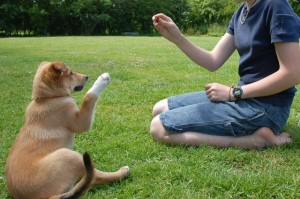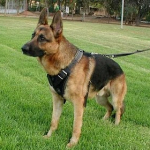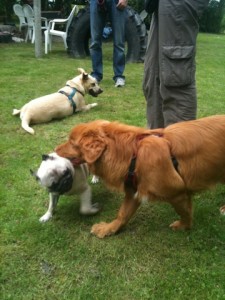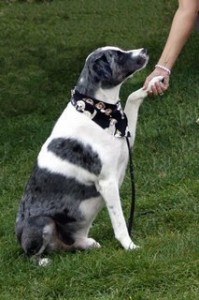Articles in the Dog Training Category
Puppy Potty Training »
Dog breeds and characteristics of several kinds of dogs
In spite of the fact that dogs all have similar traits and characteristics, there are things that separate one dog from another. There are different breeds of dogs and with these breeds of dogs come different behaviors and skills. Some dogs are more trainable than others and there is a need for you to understand the kinds of dogs available so that you select the one that best suits your needs. Dog vary in skill and in function as well as looks. There are several kinds of dogs that are trained to exhibit inherent skills. The following are sets of dogs that are trained according to what they are naturally good at:
– Detection dogs: Detection dogs are especially trained to detect things or folks. Detection dogs are used by the police force to obtain or recover missing or lost things.
– Assistance dogs: Assistance dogs refer to dogs that are trained to assist folks. These dogs are born with a natural gift for taking care of people. Assistance dogs include those that are trained to lead blind individuals or look after disabled folks. They are naturally sensitive to the needs of their owners and tend to anticipate their needs.
– Herding dogs: Herding dogs are dogs that are used to protect and guide cattle or sheep and goats. Herding dogs herd. That is what they are good at. They are trained to check that not a single cow, sheep or goat is lost on the way and are also trained to keep a sharp eye on predators.
– Guard dogs: Guard dogs are trained to offer security and protection to people and property. Guard dogs are naturally territorial and are trained to exhibit that territorial trait when it is necessary. Guard dogs are trained to either be in attack mode when their owners are away or at ease mode when the owner is back.
[caption id="attachment_1604" align="aligncenter" width="300" caption="Dog breeds chart comparing breeds"] [/caption]
[/caption]
The kind of dog you want will depend to a large extent on your purpose for it so, choose with care.
Even if you send your dog away to training school, you will eventually have to be present at a point during the training to learn all about the commands your dog is responding to. Contrary to what some people think, a dog cannot be trained in your absence because you need to be the one to issue out the commands. Your dog needs to get used to your tone of voice before it responds to any command that you issue.
Photo source:mydogs4you.blogspot.com
Dog Training »
Things need to certify to start training your dog
[caption id="attachment_1600" align="alignright" width="300" caption="Small Dogs and Big Dogs"] [/caption]
[/caption]
If you are pondering about training your dog, you should know that while it isn’t a Herculean task, it isn’t a walk in the park either. There are several things that you need to make sure are in place before you commence training your dog. The fact about the matter is that dog training involves the balance of scores of factors that contribute to the success of training your dog. If you want to start training your dog, you need to certify the following:
– The age: There is a certain age that your dog will be before it can be trained successfully. If you train your dog too early, you can get stumped because its motor and socialization skills are still a bit tender. The right time to begin training your dog is when it is between three and six months old. If you make the mistake of training your dog later than that, you may not be able to get it to do anything you say because it would have developed its own behaviors already.
– Health: A healthy dog is customarily a trainable dog. You need to certify that your dog is in the best of health before you train it. A dog that has not been properly vaccinated against diseases may be prone to fall sick often in the course of training. Before you proceed with training your dog, certify that it is in a perfect state of health. commonly, dog training schools dont admit dogs that are not fully vaccinated.
– Localization: There is a certain period in the development of a dog where it becomes so attached to a particular place that removing it from there can induce a myriad of difficulties. You need to ensure that before your dog attains this stage that it is moved to the area or location where you want it trained to prevent any resistance on its part. You also need to check that your dog has exceeded the stage in which it is terrified of strangers in order to make the dog trainers work easier.
Photo source:mydogs4you.blogspot.com/
Basic Dog Commands, Dog Training »
The five essential commands in dog-training
Every time I read a dog training book these days, it seems like I learn something new or find out a new strategy, command, tool, toy, schedule, piece of advice, etc, etc, etc… When I first started researching dog training techniques and found the incredibly huge wealth of information out there regarding dog training, I got a bit nervous. Would I really have to read all that stuff and figure out how to interpret all that mambo-jumbo before I was able to successfully train my dogs?
And it wasn’t just the amount of information available on dog training that was the problem. It seems like every single dog trainer out there has opposing ideas, techniques, and philosophies about dog training. Literally every book, website, and brochure I read would say something to contradict the one before.
Needless to say, I had very little success with my dog training at first because I was always adjusting my strategies, and was not consistent. Perhaps you are currently (or have recently been) in the same situation.
After three long years of this with my two dogs, I finally decided to look once and for all for an answer. I was tired of poring over dog books and reading every “latest and greatest” training theory. I decided to contact someone who I knew would be able to give me a straight and real answer – something that actually works.
So, I talked to a professional dog trainer named Paula who hass been working with dogs for over twenty-five years. I knew that if anybody could help me, it would be her, since she has to have been doing something right this whole time!
[caption id="attachment_1593" align="aligncenter" width="300" caption="Dog training commands"] [/caption]
[/caption]
The Formula
What I learned from her was really amazing to me, and it really lifted a big weight off my shoulders. I have always considered dog training to be a mysterious, difficult process and until I spoke with my life-saver friend Paula, I thought that while I might be capable of training my pups to do simple things like “sit”, I would never be able to train them to the level that the pros do. But when I spoke to Paula about my problem, she was kind enough to spell out the entire process of dog training. (And it didn’t take that long, believe me– its a lot simpler than I expected.)
Paula told me this: there are five essential “pillars” involved in dog-training. Once you’ve mastered these five pillars with your dog, you can train him to do anything and everything. I dont know about you, but hearing that I could successfully train my dog with only five commands made me feel a little bit better.
And what are those 5 commands?
This is the list of obedience pillars that Paula spelled out for me: “Sit”, “Stay”, “Down”, “Come”, and “Heel”. Once your dog knows these commands, you’ve formed the foundation on which any other training can be built.
Now if you know exactly how to accomplish this training with your dog, then you have no reason to listen to me any more and I hope you enjoyed reading this report. But if you’re not completely sure what your first step should be or how to instill these commands, you’re not alone.
To learn how to successfully train your dog to perform these commands, and how to use them to build your dogs obedience foundation in order to train him for bigger and better things, you’ll need a little guidance just like I did.
Photo source:dogfocus.blogspot.com
Dog Training, German Shepherd »

You have a new puppy at home? That is really great since German Shepherds will give you real companionship that comes with loyalty, and commitment to protect you whatever happens. They are really smart, very active, and trainable. So, this early you can really have fun teaching your puppy some tricks that he can master as he grows.
Dog Training »
An untrained dog can be a real pain in the butt and that is a fact. If you really want to enjoy your dog and all its inherent qualities, you will have to train it or have it trained. There are some don’ts that you should know about in the course of training a dog that will enable you have successful dog training session.
Dog Training »
Dog training schools can change your dogs behavior
[caption id="attachment_1559" align="alignright" width="225" caption="Dog Training School"] [/caption]
[/caption]
Raising an obedient dog that listens to what you tell it is a very desirable thing. To accomplish this, you might want to consider sending your dog to a training school. A trainer at the school would teach your dog proper behavior. Dog training schools can entirely change your dogs behavior. Following the training, the dog will be obedient and you will not have to worry about always watching him to make sure he is not chewing up lots of things.
Dog training schools are there to help out dog owners whose pets need to be taught how to behave in public, and they are instrumental in creating an enjoyable lifestyle for you and your pet. Some dog owners even take the same kind of care in deciding on the dog training schools that their dogs should attend as they do in selecting their children’s schools. Of course, it pays for you to first investigate different dog training schools and you should choose one in which you will also be a big part in the general training of your dog.
Its important to use recommendations to determine what dog training school is best for you. Your colleagues or neighbors may have experience with different schools, or you could ask a dog training expert which school would be good for your dog. Its also a good idea to visit the facilities in person before you choose. Make sure its in a good neighborhood, and try to get a feel for the place by looking around and speaking with the staff. Unless your dog is happy with his environment, he wont get the best training.
Of course, the clincher would be that both the dog and you are happy with the trainer at the dog training school, since anything else will certainly end up being a waste of time and money. Remember also that most dog training schools do not target dogs in their very early years despite the fact that young dogs will adapt very well. What is important to understand is that your dog should be taken to a dog training school where he is treated with gentleness and given adequate love and shown plenty of patience, which will ensure that he will come out from his training program a well behaved and problem-free dog.
Photo source:reditoller.wordpress.com
Dog Tips, Dog Training »
Dog training is a science and theories have been written
[caption id="attachment_1553" align="alignright" width="150" caption="Effective Dog Training"] [/caption]
[/caption]
Did you know that dog training is a science? Dog training has created a series of studies around the world with the purpose of deepening mans understanding of dogs and increasing the relationship between man and dog.
Dogs in the course of training have been studied and countless theories have been written on them. The learning theory of dog training is a theory that has been propounded based on the messages that a handler sends out to a dog. The learning theory incorporates four necessary messages that constitute the bulk of the training session:
Messages that a handler sends out to a dog
– Release marker: A release marker is also known as a gift marker and is mainly a message that the handler sends out to a dog to let it know that it has flaunted the desirable deeds and has carried a gift. The release marker is almost instantly followed by a present for the dog, which may be a treat, or something the dog particularly likes.
– Keep going signal: This message is handed to the dog while it is in the process of demonstrating a requisite behavior. Mainly, the keep going signal tells a dog that if it keeps up its action, it will get a present. Words such as come on or good commune this to the dog.
– No present marker: The no souvenir marker is used to let a dog know that it has not showed the apposite conduct and will probably have to commence again. Words such as uh-oh or try again are used to express this message.
– Punishment marker: The punishment marker is used to let the dog know that it has not behaved well at all and will receive punishment. A dog knows that it has erred when it receives this message. Words such as no or off are used to put across this.
These four markers are regularly used by dog trainers to tune their dogs into what they want them to do.
Photot source:learn-noweducatingonline.blogspot.com
Basic Dog Commands, Dog Training »
Dog training respond to hand signals
[caption id="attachment_1504" align="alignright" width="200" caption="Dog training hand signals"] [/caption]
[/caption]
When you are training your dog to respond to your verbal commands, you can train him to respond to hand signals also. These can be learned in conjunction with the verbal commands and can be very usual in certain situations. There are a few common hand signals that you can teach your dog.
When you are training your dog, the very first command that you should teach him is the sit command. Teach him the verbal command first and then you can incorporate the hand signal. The hand signal for sit is to start with your right arm at your side, bend your arm at the elbow with the palm facing up. Slowly bend the arm until it is above the dogs head. Do this while giving the verbal sit command. Once he seems to have that mastered, do the motion without the verbal command. If he follows the hand signal, praise him immediately and give him a treat.
Once he has the sit command mastered you can teach him the down command. This command will have the dog lay down with head up and paws forward. This is one of the first verbal commands that has a hand signal. Once your dog learns the down command, incorporate the hand signal into the lesson. The hand signal for down is palm down, fingers together and you slowly lower your hand to the ground. Keep your dog focused on your hand signal as he obeys your verbal command. Slowly, verbalize the command in a softer and softer tone until he is able to do the command on hand signal alone.
The next hand signal that you can teach your dog is the come signal. When teaching your dog to come on command use his name first and then say Come. If he comes right away, praise him greatly and give him a treat. If he doesn’t come you may have to pull his leash toward you while saying his name and the word come. Once he has the verbal command mastered, just add the hand signal. The hand signal for come is the same as the hand signal for a person to come. Bend your right arm at the elbow and move in backward toward your left shoulder in one sweeping motion. Make sure you have your dogs undivided attention when using the hand signal.
Teaching your dog hand signals along with the verbal signals can be very usual if you need to get your dog to obey you in a crowded, noisy area. It can also be usual as your dog grows older and his hearing declines. The most important thing is to never hit or spank your dog. You do not want your dog to associate your hands with pain. Be patient with your dog and before you know it he will be obeying your every command!
Photo source:sitmeanssit.com
Dog Training, Dog Training Books »
Dog training aspects
The fact about dogs is that they are adorable creatures that can be a handful if they aren’t properly minded. Dog owners have different reasons for training their dogs. A dog may be well trained in one area and be total flop in another. The different aspects of dog training demand that you train your dog extensively to get the best behavior from it. The aspects in which dogs are generally trained include:
– Barking: Some dogs just don’t know when to stop barking! If your dog has continuous barking problem, training it to know the right time to bark will assist. A dog can be trained to bark using dog training tools such as the crate or an electronic collar. On the reverse side, some dogs may not be able to bark at all. In such cases, taking your dog to see an animal psychologist also constitutes training.
– Potty training: A dog needs to be house trained if it is going to stay in the confines of the home. Trust me, waking up to find your dog left you a package in the middle of the kitchen floor can spoil your day. House training methods vary from dog owner to dog owner. While some dog owners may use tissues or a litter boxes others may use a crate.
– Chewing: Dogs need to be trained not to chew. It can be frustrating to have a dog that nibbles everything you have from your bathroom slippers to your cushion pillows. obtaining a chew toy or a dog toy for your dog forms part of its training as it learns not to chew your stuff.
– Obedience: This forms the main part of dog training sessions. A dog that does not know how to listen to its masters voice can be a troublemaker. All dogs need to learn how to obey their owners and therein lies the secret to having a good dog.
– Tricks: Some dogs are trained to perform tricks like shaking hands with a stranger or standing on their hind legs. Training a dog to conduct tricks may be for entertainment or even as a source of income.
[caption id="attachment_1497" align="aligncenter" width="300" caption="Dog training aspects"] [/caption]
[/caption]
Don’t make the mistake of buying plush toys for your dog to chew on because it won’t be able to tell the difference between a plush toy and a plush pillow. In selecting chew toys for your dog, buy a few that are the same in size and color in other to help your dog keep track of them. Buying your dog a myriad of chew toys can confuse it and defeat the aim of distracting it from chewing your valuables.
Photo source:welcomedoglovers.blogspot.com
Dog Training »
Most basic dog trick is the handshake trick
[caption id="attachment_1529" align="alignright" width="199" caption="Dog handshake training tip"] [/caption]
[/caption]
Sometimes, dog training isn’t all about getting your dog to obey you. Dog training can be for the purpose of catching good old fun. Some dog owners teach their dogs how to carry out certain tricks for different reasons. Its not uncommon to see dogs in the circus delighting thousands of human beings with their tricks. Some dog owners teach their dogs tricks strictly to entertain guests who come to the house or to earn an income. A dog that can turn a trick or two is bound to induce a happy viewer to pull out a couple of dollar bills.
Dog tricks are of various kinds. You can teach dog complex tricks such as jumping through hoops of fire or stick to simple tricks such as shaking hands. A dog that can shake your hand brings a grin of delight on your face. If you are teaching your dog any tricks, you should certify that it is fun process. If you turn the trick learning process for your dog into a military chore, your dog wont derive an iota of joy learning them. On the contrary, it will probably rebel against learning them.
The most basic dog tricks you can teach your dog is the handshake trick. You can teach your dog the handshake trick by making it sit in front of you and lifting its paw gently to shake. After you do this, reward the dog. With time, simply stretching your hand towards your dog will induce it to put its paw into your palm. The handshake trick is pretty easy for your dog to learn.
You can also teach your dog the carry trick. This enables your dog to carry your bags or your things in its mouth. It can be a delight to watch your dog trotting across the parking lot with your handbag in its mouth. Some owners teach their dogs to sit down on their hind legs and raise their front paws high in the air.
Generally, most dog owners love it when their dogs are able to carry out their one trick or the other because it only endears their dogs to them.
The key to raising a healthy obedient puppy is consistency. The more you are consistent and firm with the things you want your dog to learn, the more well behaved it becomes. If you are too flexible during the training sessions for your dog, you may end up confusing it.
















 The
The